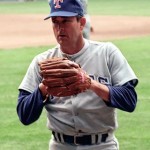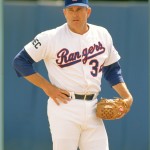What particular attributes are necessary for an ordinary kid to turn himself into a star athlete who might eventually become a big-league baseball player? Most kids, who play in Little League, dream of having the opportunity to play on a Major-League team. Those who are really good in little-league inherently understand why they are good and know that they must continue to get better in order to become a professional ball-player.



Undying “love of/for the game” is the first pre-requisite, coupled with a desire for knowing how to get better on the gradual continuum of age and maturity. If you live in Southern California, you can play baseball all year round. Some current “authorities” are now saying that it might not be beneficial to one’s long-range goal of becoming a “Major-Leaguer” to play baseball 12 months a year. Their reasoning for that kind of thinking was initiated after a rash of “Tommy-John” surgeries on young adults and teenagers made the head-lines. These “fear-struck” ‘Guardians of Youth” have suggested that children should simply play other sports like football, basketball, lacrosse, etc. so that the body parts used most vigorously in baseball would have a chance to rest.
Well, the body parts used in others sports are mostly the same as those used in baseball, especially if a person is a quarterback/pitcher. The onslaught of elbow injuries and surgeries has occurred mostly to those who are engaged in incorrect pitching and throwing mechanics.  IF a person’s arm is hurting at the end of a baseball season, he should definitely rest his arm until it is healed, then, receive proper throwing instruction if he intends to pitch during the up-coming season.
IF a person’s arm is hurting at the end of a baseball season, he should definitely rest his arm until it is healed, then, receive proper throwing instruction if he intends to pitch during the up-coming season.
There should never be a reason for not playing baseball all year round unless individuals live in an environment whose inclement weather is not conducive to playing baseball. Not everyone wants to play baseball exclusively, but those who do have the better chances to perfect the skills necessary to eventually become “Big-League” players. You never hear of proficient gymnasts, swimmers, “runners,” cyclists, skate-boarders, boxers, martial-artists, etc. taking time away from their main interests. (When I was ready to sign my first contract in the Fall after my Senior year in High School, I was out playing basketball, to show off my “carry-over” skills. I was driving for the hoop, landed on someone’s foot, and turned my ankle. I thus decreased my “signing leverage” considerably!  Remember Jim Longborg’s off-season skiing incident?
Remember Jim Longborg’s off-season skiing incident?  What about BO Jackson?
What about BO Jackson?  He never played football or baseball well again.)
He never played football or baseball well again.)
Playing other sports may have good carry-over value, but if an individual has a career in mind, as a long-term goal, more proficiency will be attained by consistent participation in his favorite sport such as baseball, tennis, etc.
When you’re a kid, through 8th grade, it is probably a good idea to play as many sports as possible, to get a feeling about what you would like to pursue when you get into High School. You can usually find out before ninth grade what sport you are most proficient at, and that which is most logical to pursue.
When you get into High School it makes the most sense to focus on one sport unless you are equally adept at two. But the higher advantage goes to the one sport athlete, unless leverage at “signing-time” is a consideration.
Swimming and running, in general, are two activities that only enhance the total condition of the body of a baseball player. The most powerful throwing arms of players with whom I played were two individuals who were “swimming champs” from the Bahamas. 


 The best runners are they who have run everywhere they went at their earliest ages, to and from school, grocery store, the park, through “bad-neighborhoods,” from bullies, from their parents, etc.
The best runners are they who have run everywhere they went at their earliest ages, to and from school, grocery store, the park, through “bad-neighborhoods,” from bullies, from their parents, etc.


Before 9th grade, after a baseball season has concluded, those who want to play more baseball should do so in a moderate way in order to allow the mind and body a release from the tension due to the intensity of the regular competitive season. Now would be a good time to play the game strictly for the fun of “it” (like in the ‘old’ days”).
For those who really love to play baseball, and do not want to play football, basketball, or the myriad other sports to fill the void between baseball seasons, I recommend the forming of informal “choose-up” leagues in which an adult or young adult is the pitcher and throws pitches to players on both teams (according to the batter’s ability) while every one on each team has the opportunity to play a different position each inning. In this way regular baseball skills are reinforced and no kid has the responsibility of Pitching, nor is there an unnecessary risk of shoulder or elbow injury, even while all players are keeping their arms in decent shape for the next “real” baseball season.
Now, here is where “specificity of movement” plays its role for the conscientious devotee. The “Specificity of Motion-Movement” Principle is probably the best policy to practice if any pitcher or fielder (batter as well) would want to train his body and arm(s) properly and condition them to sustain the physical and mental well-being during an entire Baseball career.
Even while “having fun” playing baseball in “informal” sandlot games (as prescribed above) will keep players in relatively good baseball shape, it doesn’t mean that all players will be practicing the rudimentary skills mechanically correctly. The “off-season” is the best time for parents to hire a trained expert (if parents themselves are not qualified) to instruct their youngster(s) about the proper mechanical techniques that will insure proper development of all aspects of the student’s “Game,” from throwing and hitting a baseball to pitching, fielding, running bases, and applying the skills learned, by practical reinforcement of the movement that the body facilitates, with consistently precise application.
Lack of muscle-conditioning, over-conditioning, inappropriate training techniques, misunderstanding of how to enhance power, strength, endurance, and application of skills of “specificity” regarding the game of baseball all come into play when evaluating the safest way to procure a long and illustrious career, as a pitcher or any fielding position (as well as batter). You can’t have “flabby” muscles and expect them to be able to contract quickly and with power to facilitate movement for optimal proficiency on the professional baseball field, or any field of competitive engagement. But excessive weight-training for baseball seems equally inappropriate to facilitate the quick and natural actions needed on a baseball field. Why would a pitcher need to “Bench-press” in excess of 100 lbs., or “curl” more than 10 or 15 lbs when the ball he is expected to have mastery over weighs but 5 ounces? (The standard for extreme “Pitcher-Workouts” used to be Nolan Ryan, and I never saw a video of him working with more than 6-8 lb. “dumbbells”.)




“Weight-lifting” of any kind would not be advised for any student under 9th grade. Hard work such as “scrubbing pots and pans,” yard-work, farm-work, lots of running, climbing, swimming, hanging from bars, tree-limbs would more naturally develop a youngster’s strength without fear of damaging tendons and ligaments. And then he could apply his baseball skills with as much intensity as his body is mandated by his mind. With the right mechanical understanding and application of Principle, this type of student will thrive in his youth, and prosper incrementally on his approach to “star-dom.”
Coming Soon: Most “Stars” are born in HIgh – School!